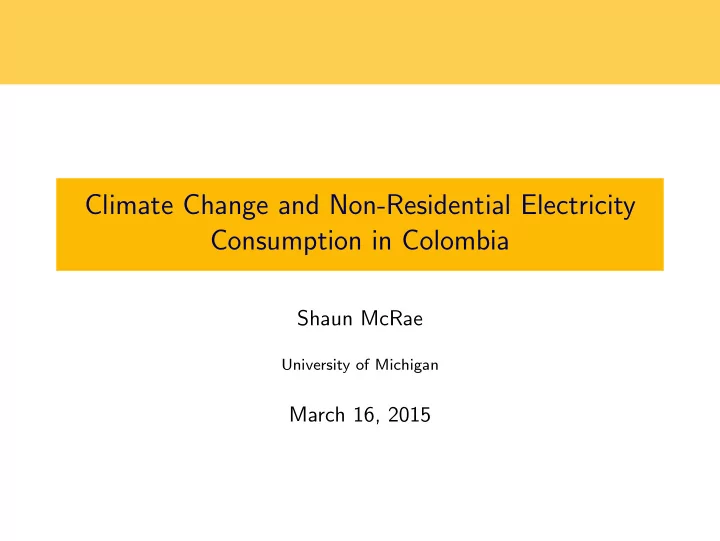

Climate Change and Non-Residential Electricity Consumption in Colombia Shaun McRae University of Michigan March 16, 2015
Adaptation and climate change Some adaptation to climate change will be required even in the most optimistic policy scenarios One form of adaptation: greater control of indoor environment • This is welfare-improving: e.g. mortality during heat waves has decreased over time (Barreca et al 2015) However, it does require greater energy consumption, which further increases CO 2 emissions
Non-residential electricity consumption and temperature Several studies examine relationship between residential electricity consumption and temperature, then use this to forecast future electricity consumption growth Effect on non-residential consumption (70% of total electricity use) is not as well studied This paper uses daily data on temperatures and non-residential electricity consumption in Colombia to estimate the short-term consumption-temperature gradient Combine this with simulation data on future temperatures in Colombia to predict consumption change from shift in temperature distribution
Electricity consumption and weather data From market operator (XM), daily data on consumption of unregulated users in Colombia, aggregated to municipality and connection voltage level • Consumption for about major 5,500 electricity users From NOAA, daily data on mean temperatures at 26 airports in Colombia • Complete data not available for many locations, especially before 2010 Data covers the period 2006 to 2014
In tropical countries there is little fluctuation in temperature at any location Daily mean temperatures for Bogota 0.50 0.40 0.30 Density 0.20 0.10 0.00 5 10 15 20 Mean daily temperature (degrees C)
Empirical methodology Split temperature data into quintiles for each location and use quintile indicators • This allows for some flexibility in the response to temperature at different parts of the distribution Undertake analysis separately by three climate zones (assigned based on mean temperature) • Below 20 degrees, 20–26 degrees, above 26 degrees
Empirical methodology Main estimation equation: � log q itm = β k D kit + φ im + ε it k q itm is electricity consumption in municipality and connection capacity i on day t in month-of-sample m φ im are municipality-capacity-month fixed effects Temperature parameters β k are identified from within-month variation in daily temperatures in each municipality
Results by climate region for Level 2 connections (voltage between 1 kV and 30 kV) Below 20 degrees Coefficients and confidence interval -0.06 -0.04 -0.02 0.00 0.02 0.04 0.06 1 2 3 4 5 Temperature quintile
Results by climate region for Level 2 connections (voltage between 1 kV and 30 kV) 20 to 26 degrees Coefficients and confidence interval -0.06 -0.04 -0.02 0.00 0.02 0.04 0.06 1 2 3 4 5 Temperature quintile
Results by climate region for Level 2 connections (voltage between 1 kV and 30 kV) Above 26 degrees Coefficients and confidence interval -0.06 -0.04 -0.02 0.00 0.02 0.04 0.06 1 2 3 4 5 Temperature quintile
Results by climate region for Level 4 connections (voltage above 57.5 kV) Below 20 degrees Coefficients and confidence interval -0.06 -0.04 -0.02 0.00 0.02 0.04 0.06 1 2 3 4 5 Temperature quintile
Results by climate region for Level 4 connections (voltage above 57.5 kV) 20 to 26 degrees Coefficients and confidence interval -0.06 -0.04 -0.02 0.00 0.02 0.04 0.06 1 2 3 4 5 Temperature quintile
Results by climate region for Level 4 connections (voltage above 57.5 kV) Above 26 degrees Coefficients and confidence interval -0.06 -0.04 -0.02 0.00 0.02 0.04 0.06 1 2 3 4 5 Temperature quintile
Connection voltage is a proxy for “commercial” versus “industrial” applications Stronger relationship between temperature and electricity use for smaller users reflects greater use for commercial real estate (instead of industrial processes) This table shows the distribution of unregulated customers by sector, for different connection capacities Connection Manufacturing Services Other Less than 1 kV 33% 54% 13% 1–30 kV 32% 53% 15% 30–57.5 kV 58% 21% 21% Above 57.5 kV 47% 5% 48%
Combine the temperature sensitivity results with simulations of future climate change Several groups have developed large-scale global climate simulation models known as General Circulation Models • These differ in the way that individual components of the climate are modeled • Each group runs alternative emissions scenarios developed by the IPCC For analysis at fine geographical and time scales, the results from these models are “downscaled” based on historical temperature distributions I show results for the A1B scenario with the CCGMC3.1 model, using downscaled data from the World Bank
Change in distribution of temperatures by location, from 1980–2000 to 2046–2065 Historical mean temperatures for Barranquilla 0.50 0.40 0.30 Density 0.20 0.10 0.00 20 25 30 35 Temperature (degrees C)
Change in distribution of temperatures by location, from 1980–2000 to 2046–2065 Historical and future mean temperatures for Barranquilla 0.50 0.40 0.30 Density 0.20 0.10 0.00 20 25 30 35 Temperature (degrees C)
Change in temperature distribution predicted to increase non-residential consumption by 1.1% by 2046–2065 Greatest growth in usage for smaller customers with consumption that is most sensitive to temperature Connection Demand (GWh) % increase Less than 1 kV 208.1 1.9% 1–30 kV 5181.1 2.0% 30–57.5 kV 5089.9 1.0% Above 57.5 kV 3478.1 0.3% Aggregate 13957.2 1.1%
Discussion: weather vs climate The above analysis uses very short-term temperature fluctuations to study the effect of very long-term term climate change Assumption is that the electricity consumption and temperature relationship will stay constant within each region • Unlikely to be true if there are changes in e.g. air conditioning penetration as the result of climate change Changes in industrial composition may also increase weight of more temperature-sensitive applications Results are lower bound on overall impact of climate change on non-residential electricity consumption
Recommend
More recommend